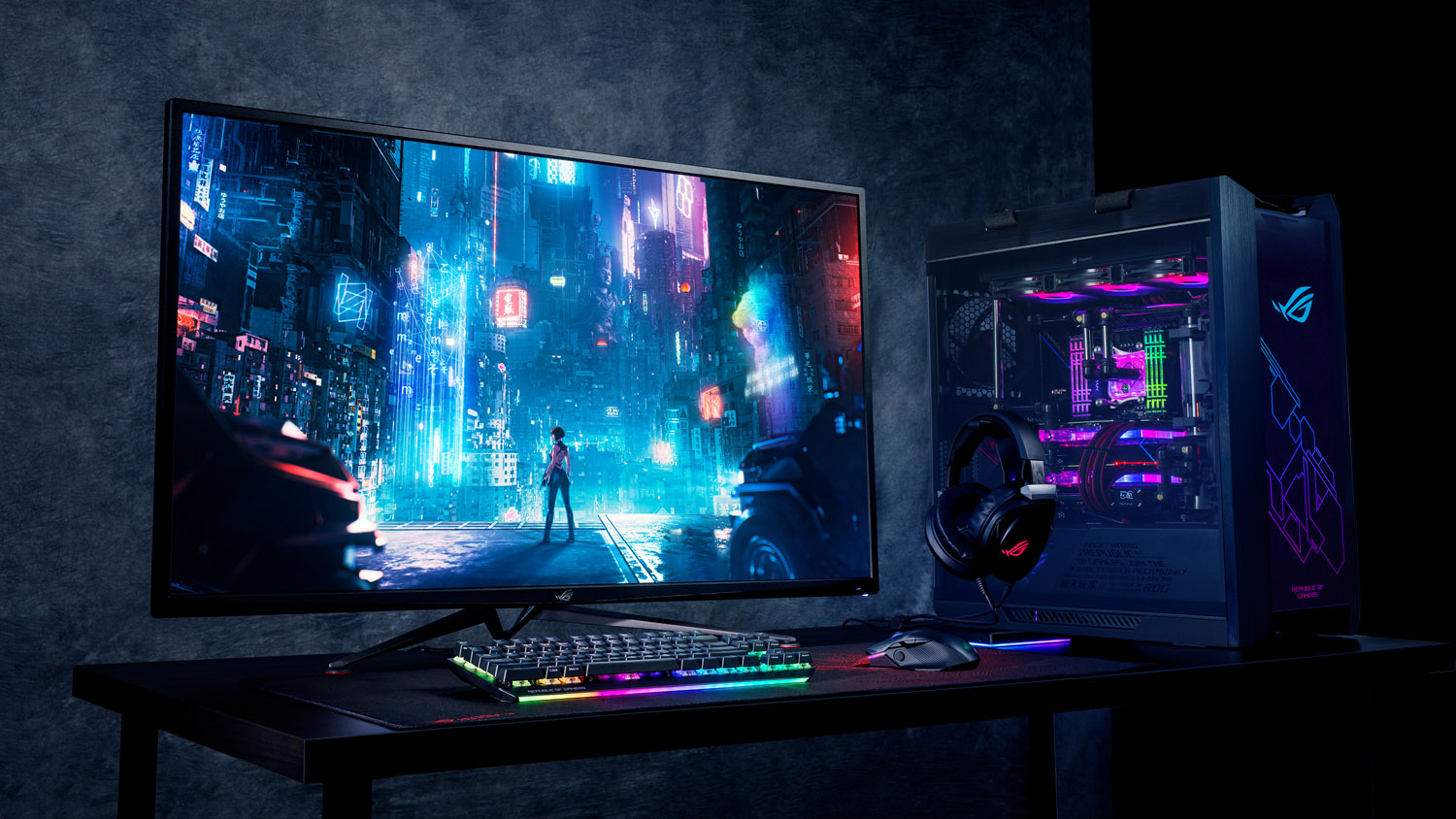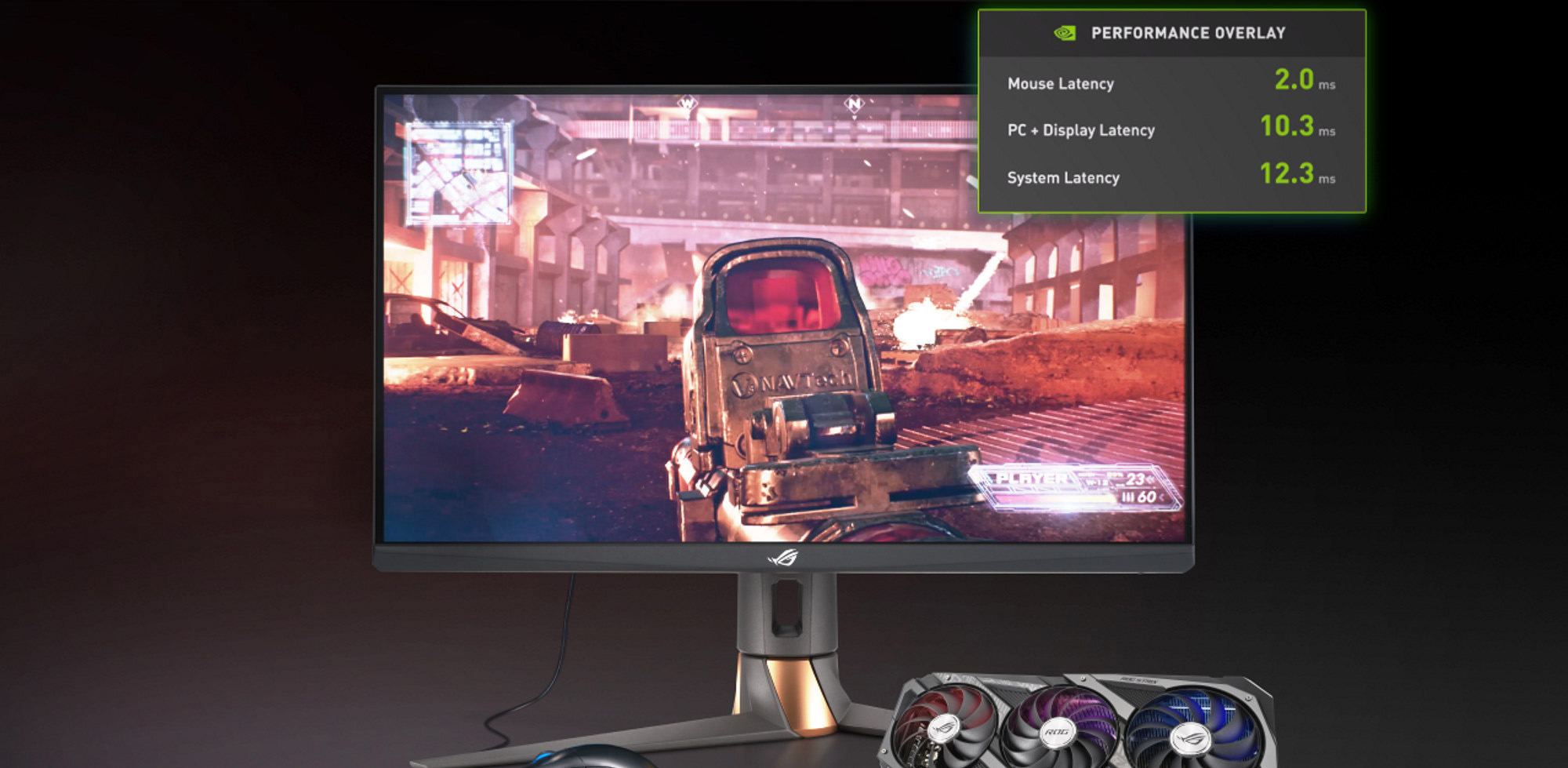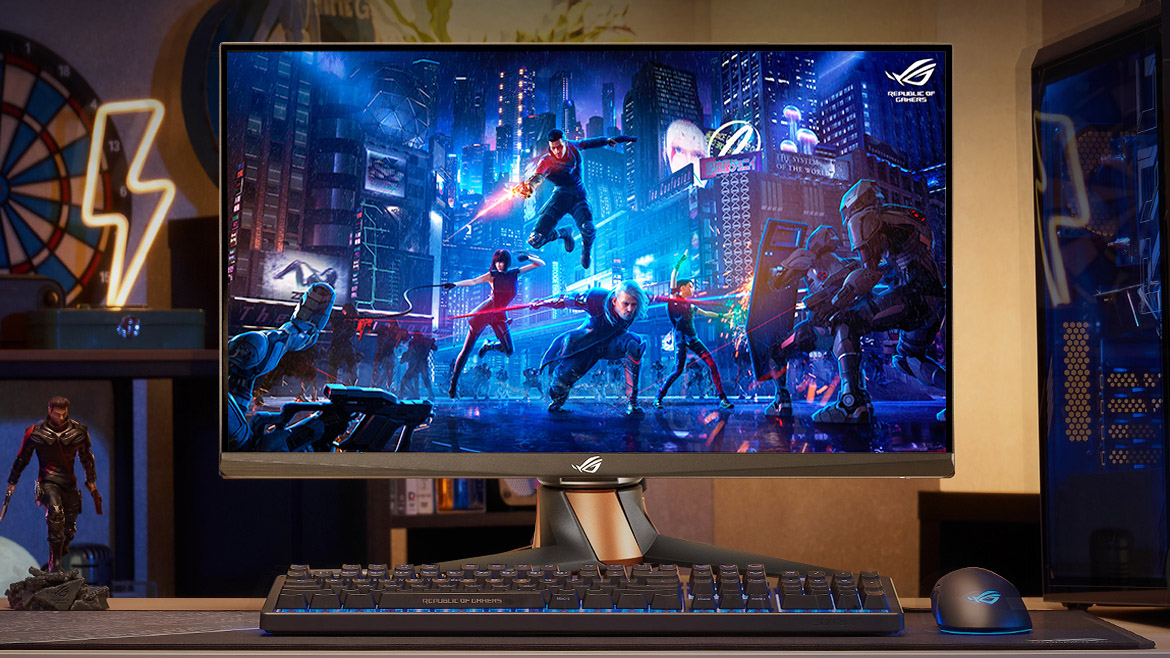How To Set Up A Gaming Monitor

Your PC's monitor is a portal to some other world, the window to every game you play. Information technology'due south easy to become caught up in the specs of your PC and the power of your graphics menu, but your brandish is just as important in determining the concluding image that reaches your eyeballs—and so information technology's of import to set it up properly. Here are all the settings you should tweak when y'all unbox your new gaming display.
First: Adjust the physical
Once you've put your monitor together and set up information technology on the desk, you'll desire to get the stand up prepare to its optimal tiptop and bending. This isn't only for ergonomics (though that'southward a big function of it)—viewing angles can affect the colors on screen, and then you lot desire to make sure the screen is in the best spot for your optics to accurately translate the display's color and contrast. If the display is also loftier or too depression, or at a strange bending, the colors may shift or look washed out.
Ideally, you should adjust the height of your monitor so that the top is near or just to a higher place middle level. Most ROG monitors back up height aligning (save for a few big format and portable displays where information technology wouldn't make sense), and this is crucial for a good experience. In that location's no reason you should have to deal with a monitor that only has tilt support, forcing yous to stack it on a bunch of books for proper ergonomics.
Next, adjust the display's tilt so that you're looking at the screen directly on. Effort to avoid direct sunlight from windows if you can, though monitors with a high brightness spec (over 300 nits) can help overcome this glare–more on adjusting effulgence in a bit.
Finally, ROG monitors also come with cable direction congenital into the stand up, so you tin can go on cables tucked abroad and out of sight for a super clean battlestation. Again, don't settle for lesser monitors that force your cables into a messy rat'southward nest. Oh, and use DisplayPort if at all possible—in most cases, it'll support the best resolutions and refresh rates your monitor has to offer, while HDMI may be more than limited on certain displays.
Selection Your Preset

ASUS and ROG monitors have a number of presets congenital-in that decide the contrast, color, and vibrancy of the image on screen. Which i you choose volition depend on your goals: practice yous want colors accurate to the original mastering of the game? Exercise yous want an image that really "pops" with vivid colors? Or practise you want a competitive reward over your opponents above all else? The answer may vary from person to person and even game to game, so don't be afraid to play with dissimilar settings as yous explore different titles.
To accommodate your monitor'southward settings, press the settings button, usually located on the back, side, or bottom of your monitor. You'll see an overlay pop upwards on the bottom of your screen, called the on-screen brandish (or OSD), which yous tin navigate with those same buttons. Almost all ROG monitors have a joystick-manner control, though, which is much easier to use: you tin can move it left, right, upwards, and down to navigate these menus, and printing inward on information technology to select. Yous'll find the picture presets nether the GameVisual category.
Racing is often a dandy setting to try, even if you aren't playing a racing game–it offers vibrant colors, peculiarly on monitors with a wide color gamut, and has depression input lag correct out of the box. Many wide gamut monitors as well have an sRGB mode, which clamps the colors into a narrower space. sRGB way is less vibrant, only the colors will actually be more than accurate to the game's original design, since games are mastered in this colour infinite (unless you're playing in HDR). This way is too ideal for content creation, so you know how your photos or video will appear on other displays.
Other settings are designed to suit sure types of games. The MOBA preset enhances the colors of your opponents' health and mana bars, while FPS offers higher contrast to enhance visibility of your enemies. If you like to tweak, you can alternatively go with User mode and accommodate the R-G-B white balance by eye, or with a colorimeter.
In one case you've picked your base of operations preset, you tin adjust the effulgence setting to fit your room's needs–low brightness will exist fine at night (and offer deeper, darker blacks), just during the day you lot may need higher levels to overcome sunlight. If your monitor has a Local Dimming or Variable Backlight setting, like our ROG Swift PG32UQX, you're in for a real treat. This allows the backlight to dim down in different zones across the display, assuasive for deeper blacks and brighter whites for an image that truly "pops". Yous tin can conform this setting to taste as well—dissimilar settings allow for more than aggressive dimming and thus deeper blacks, and so play with information technology in-game to see what you like best. Other settings like dissimilarity can unremarkably be left alone, but if a preset isn't quite where you desire it to be, you tin dial information technology in to your exact preferences.
All of these settings apply to gaming in standard dynamic range, or SDR. If your monitor is capable of HDR, information technology should automatically kick in to a split up HDR mode when the monitor detects an HDR indicate. Some games require you lot to flip the "Enable HDR" switch in Windows' HDR settings beginning, then enable information technology in game, while other games will do it automatically when yous enable HDR in the game's settings. (And a third subset of games support Windows 11's new Auto HDR feature, which requires Windows' HDR setting to be flipped on.) If you lot aren't certain whether you're playing in HDR, launch the game in question, turn HDR on, and open up your monitor's settings–it should say "HDR" somewhere in the OSD if it'southward detecting an HDR signal.
Set your refresh rate

Every frame counts when you're trying to get the leap on your enemy. And then if you're rocking a loftier-refresh 144Hz, 240Hz, or even 360hz monitor, brand sure you lot're getting every frame you paid for. To start, if your monitor has a refresh rate overclocking setting, like the blazing 270Hz on the ROG XG27AQM, be sure to turn information technology on for the highest refresh rates. (Again, DisplayPort may be necessary to make the most of this feature.) If yous don't enable this overclocking feature in your monitor'due south OSD, that top-terminate refresh rate won't appear in Windows' settings to select.
Next, right-click on the desktop and open Windows' Display Settings. Ringlet downwards to Avant-garde Display Settings and select your monitor from the dropdown at the elevation (if information technology isn't selected already). Further down this folio, you should see a dropdown marked Refresh Rate–click that, and brand sure it's set up as high as information technology volition go. The higher your refresh rate, the smoother movement will announced in-game, and the quicker you'll come across enemies sally from cover.
If your display supports Adaptive Sync, you'll desire to enable this as well to reduce screen tearing. From your monitor's OSD, find the Chiliad-SYNC or FreeSync pick and make sure information technology's turned on. So, open up your graphics driver'due south options to enable it at that place besides. If you have an NVIDIA graphics carte, right-click the desktop and choose NVIDIA Control Panel, choose Set up G-SYNC, and bank check the "Enable" box at the peak of the window. Make sure the correct display is selected and, if information technology's a G-SYNC compatible display (rather than a display with a K-SYNC chip in it), select the "Enable settings for the selected display model" box before clicking Utilize. If you accept an AMD graphics card, right-click the desktop and select AMD Radeon Software. Click the gear icon in the upper-right corner, choose the Display tab, and set Radeon FreeSync to Enabled.
Put 'er in Overdrive

Non to be dislocated with the refresh rate or input lag of a monitor, response time determines how fast a display tin shift from i color or shade to some other. Certain transitions may take longer than others, which tin result in "ghosting," or a blurry trail behind moving objects. Certain panel types have faster response times than others–IPS panels tend to be faster than VA panels, with ROG'southward "Fast IPS" panels being insanely quick, offering lightning-fast response times to match their high refresh rates of 240Hz and across.
You can farther improve a panel'southward native response fourth dimension, nevertheless, with the Overdrive setting. Every bit its name suggests, this "overdrives" the pixels to event in faster response times for clearer, smoother motion, which is crucial in fast-paced combat. Y'all don't necessarily want to only gear up it to its highest setting and call it a day, though. While lower settings can result in a bit more ghosting, setting it too loftier can cause "overshoot," which can crusade changed ghosting, or a colored trail backside moving objects.
Picking the right overdrive setting is a delicate balance between these two forces, and much of it is personal preference, or may vary from game to game. You lot may find that the epitome looks all-time to you with a college or lower Overdrive setting than the monitor comes with out of the box, or than your friend uses. You might even find one overdrive setting is better for loftier framerate gaming, while another is better for depression framerate gaming. Our Variable Overdrive feature, available on certain monitors, takes this into account and adjusts your monitor'southward overdrive based on the framerate of your game.
The Mistiness Busters UFO Ghosting Exam can help you dial in the correct setting for yous–put that on your screen and flip between overdrive options to see its effect. At the end of the day, though, real gaming content is the terminal decider of which setting you utilise, so observe a dark scene and test it there as well.
Enable extra features that put you on top

Finally, ROG monitors come with a number of extras designed to give you a competitive reward over your opponents. Dark Boost, for case, does it exactly what it sounds like: it boosts near-black levels and so you can more than clearly meet enemies hiding in the shadows, then you can strike before they do.
Under GamePlus, you'll also notice a Crosshair option, which lets you overlay a crosshair on the screen—useful for grooming in titles that don't give you an in-game crosshair. (Some may consider this cheating in bodily matches, though, so be careful!) You can also enable a timer that lets yous runway your target game rate in real-time or turn-based strategy games, and see an FPS counter to ensure everything is running smoothly without framerate dips.
Many ROG and TUF monitors back up our Extreme Depression Motility Blur technology, or ELMB. ELMB inserts black frames in between the frames of your content to reduce motion blur even further, allowing for an extremely clear view of your enemy'due south position. On many monitors, yous may have to disable Adaptive Sync for ELMB to become bachelor, though many premium monitors like the ROG Swift PG329Q back up ELMB Sync. ELMB Sync allows you to utilize both ELMB and Adaptive Sync at the same time, which is crucial for competitive gamers who want the benefits of low motion mistiness technology and variable refresh rate. Don't settle for just one or the other.
Speaking of competitive gaming, a few of our esports-focused monitors, like the QHD 240Hz ROG Swift PG279QM, even include NVIDIA'southward Reflex Latency Analyzer. By plugging your mouse and keyboard into the monitor, you lot can really measure out the push button-to-pixel delay of your unabridged setup, assuasive you to dial in the correct monitor and in-game settings for minimum input lag.
Finally, don't forget to cap it all off with some sick RGB effects. If your monitor has RGB capabilities, you'll discover some basic settings in the monitor'due south OSD that allow y'all to cull a color or pattern, and potentially even accommodate the speed of the animation. However, past plugging your monitor into your computer using the included USB cable, you'll be able to connect your monitor to Aura Sync through our Armoury Crate software, allowing you to sync up your monitor'southward RGB with other Aura compatible components and peripherals—like your ROG motherboard, ROG graphics card, or ROG mouse and keyboard.
Create shortcuts to your favorite settings

Finally, if you want to conform whatever of these settings on-the-fly for different games, you lot can customize the shortcuts in your monitor'due south on-screen display. I, for example, accept my starting time shortcut set to GameVisual, then I can alter presets with a few clicks depending on the game I'1000 playing.
To set up shortcuts, open the OSD and find the Shortcut option, if your monitor supports it. Information technology volition requite yous a few slots that you tin assign to a number of different features for quick access. Then, when yous want to modify that setting (in my case, my GameVisual preset), yous can merely click the respective shortcut push button on your monitor. Your monitor may also support Customized Settings, allowing you to create a few "profiles" based on your preferences for different games or activities. These are like the built-in GameVisual presets, only incorporate all your saved and customized settings.
Once you have everything dialed in just correct, make sure you salvage everything equally a customized setting—or snap a few photos so you don't forget the ideal configuration—and jump into your games. With the right settings, you'll find that everything looks a scrap smoother, clearer, and more than vibrant than e'er before.
How To Set Up A Gaming Monitor,
Source: https://rog.asus.com/articles/guides/settings-guide-how-to-set-up-your-gaming-monitor/
Posted by: collisonthaddled1968.blogspot.com


0 Response to "How To Set Up A Gaming Monitor"
Post a Comment